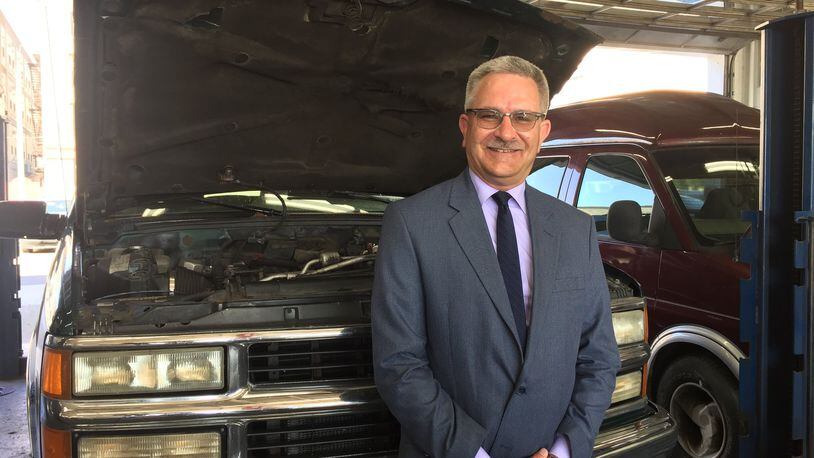On a scale from one to five, with five being a totally automated vehicle transportation system, today’s vehicles and their drivers are already between “1.5” to “2,” Kazmierczak said, due to such systems as adaptive cruise control, automatic braking, self-parking, crash avoidance and lane departure warning.
“Those are all autonomous features in the marketplace today,” he said.
A “3” on the system would represent vehicles that are automated but when an issue arises, a human being intervenes. That point on the scale will be largely ignored, Kazmierczak said, because people will embrace the safety, performance and convenience autonomous vehicles offer, and because human beings react much more slowly than the vehicles can.
“The next step will be a Level 4, which is full autonomy with still controls in the car. Level 5 is full autonomy but without controls in the car,” he said.
Challenges in acceptance, infrastructure
It will feel weird to get behind the wheel of a vehicle and it will drive itself, Kazmierczak said, and people will have to address their fears about that. But consumer safety will benefit.
“That’s really what AAA’s point of view is on vehicle autonomy — making sure that when it does come, it is safe,” he said. “It’s really about making the road a safer place.”
The second challenge will be building the needed infrastructure, he said.
“There’s a lot of preparation in the municipalities to get ready for autonomous vehicles coming in the future,” Kazmierczak said.
There will be a long period of time in which largely non-autonomous vehicles, like those being driven today, coexist on the roads with autonomous vehicles, but sensors in the latter vehicles will help avoid crashes, he said.
“The autonomous vehicles will communicate with each other to space traffic and more, but will recognize vehicles they can’t communicate with,” he said. “Rather than having a traffic jam, the vehicle will recognize that it has a non-autonomous vehicle next to it and will react appropriately.”
A system of self-driving semi-trucks called Otto already is being tested on the Ohio Turnpike.
The convenience factor
People who are unable to drive today, from the young to the elderly to those who are physically challenged, will be able to be in a car by themselves and get where they need to go, he said.
“This will change their world and I think this will be a fantastic thing, because it will change how they can travel today,” he said. “They will still have their independence.”
Vehicle theft will decrease, Kazmierczak predicts, as embedded systems will make stealing a vehicle more difficult.
Vehicle breakdowns will still occur, but the automotive service industry is preparing for how to handle those, with AAA studying the issue, he said.
Autonomous vehicle technology will be exciting for motorists, Kazmierczak said. “Everybody should have an open mind about it and certainly not be concerned. Look forward to it – it’s coming.”
A speaker at a conference Kazmierczak recently attended noted how quickly consumers embraced smart phones once they experienced them, and said people will do the same with autonomous vehicles.
“Once the people experience the advantages of autonomy … the adoption will be quick and they’ll want it. Manufacturers will have to keep up with demand,” he said.
“The transformation we’re going to see in transportation is going to be larger than what we saw when we went from horse and buggy to the car,” said Cindy Antrican, manager of public and government affairs, AAA Allied Group. “And what better car to tell that story than (one in) Dayton, Ohio? The self-starter was developed right down the street.”
People may be hesitant or fearful about the transformation, but need to remember one key point, she said: “Ninety-four percent of all vehicle crashes are caused by human error. Car crashes are the leading cause of death for teenagers. Can you imagine the number of lives that are going to be saved or preserved where people still have a good quality of life?”
“This is where it starts; it has far-reaching effects. It goes beyond a driver’s car,” she said. “It’s the most exciting thing I’ll see in my lifetime. As we see more and learn more, we’ll become more comfortable.”
Addressing information privacy
Auto manufacturers are aware of people’s privacy concerns and are working to address those, Kazmierczak said.
“They’re making sure safeguards are in place so this information cannot be hacked,” he said. “Vehicle information, like a problem your vehicle is having, will be shared with your dealership or wherever you are going to have it fixed, but that’s all. The rest of the information will be guarded.”
Alas for speed demons and lead foots
Variable speed zones already exist on some city expressways, he said, with traffic flow professionals watching expressways looking for issues. “Then they can slow or increase the traffic flow based on speed limits,” he noted.
“People who like to drive fast – they’re not going to like it when the vehicle is in control,” Kazmierczak said. “All the cars will be talking to each other. With the cars communicating like that, it’s really going to make our driving experience a lot different.”
TEDx event to explore transportation’s future
TEDxWilmington (Delaware) and AAA will hold their first TEDx event, Who’s in the Driver’s Seat?, dedicated to exploring the future of transportation via Livestream for free Oct. 17 from 1 to 5 p.m.
“We want to explore what a more mobile future looks like – from the impact of autonomous vehicles to supersonic travel around the globe to more integrated travel networks,” the TEDxWilmington website states.
Speakers may include professors, government officials, television personalities and transportation company founders from across the country.
About the Author
